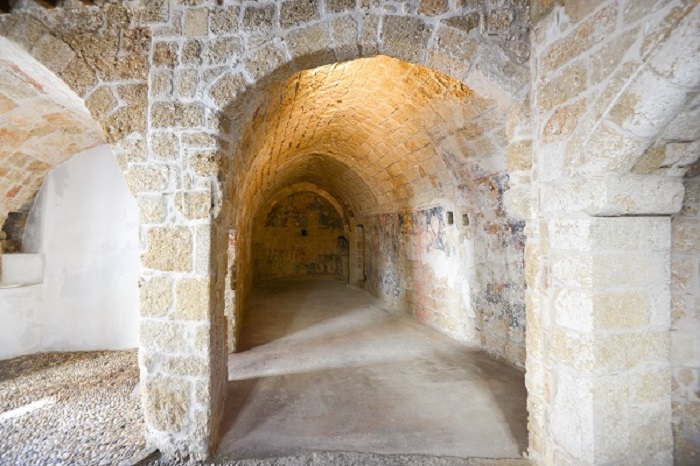SΤ. JOHN the Baptist (our chapel) [020]

HOURS: 08:00 - 21:00, all days.
ENTRANCE: Free
Opposite our hotel's entrance
ST JOHN, OUR NEXT DOOR NEIGHBOR
If the door is closed, ask as to open it for you. We can let you into what we know about the church, its links to the Gate, the neighborhood and the Castle.
We are happy that, after so many many years, it is again open to visitors. It makes us even happier to see how impressed people are by the information found in this "nutshell" about the history of the Castle, the Town within it and the sieges that led to its fall.
They can feel the agony of the ones defending it and the desire of those who wanted to have it.
Built around 1470 next to the fortification wall, short distance from the Gate on the Fort’s southern flank, the Church has been dedicated to the patron of the Knights of the Order of St. John.
It stands where a two-storey residence of a knight once stood, of which only the courtyard entrance and a window of the first floor remain. The church was originally on the ground-floor of the residence.
The Gate – as expected – was named after St. John. It is also known as “Kókkini Porta” (Red Gate), meant to remind the Greeks of all those who lost their lives on this site.
Alterations to the defense wall, artillery assaults, and, later, the fall of Rhodes in the hands of the Ottomans waged their toll on the building and its hagiographies. Immediately after the occupation, it was converted by the Turks into a mosque. Big part of the church extends underneath the stone-made steps carved into the fortification and the figures of the Saints on the walls bear witness to the tumultuous times it has seen.
There have been extensive refurbishment works, as a sequel to a project of thorough interventions for the reinstatement of the construction and the hagiographies. We are proud to have done everything we could.
Meanwhile, the knigh's residence was torn down. When life regained its normal course, much of the materials were utilized by an Ottoman Agha for his own mansion.
It was that particular Agha that also had ceramic tubes installed, to have water from a spring outside the fortress channeled to his residence. He allowed the water to flow freely in front of the house, through the marble of a Roman sarcophagus, making this invaluable gift to all of his neighbors: Ottomans, Greeks and Jews alike!
It is said that this house had always been hospitable to whoever sought refuge in it, regardless of ethnic origins or religious confession. That has also been what inspired us to convert the premises into a hotel. We wish to create this truly homely ambience that makes any visitor feel welcome. Checking in with us should be more of a homecoming.
The Hellenic Ministry of Culture entrusted us with the premises of the Church of St. John. We are taking care of it, allowing for the peace and calmness missed over most of the last six hundred years to be restored.
Those wishing to share its memories are welcome.
Bombing and vandalism were followed by many years of neglect. Hard work and dedication have stopped the church from being further destroyed. Now, constant care is needed for the old building not to collapse under the weight of its 600 years.
It took four year of restoration work to bring the church to the state it is now. The scars of the church's troubled past will never go.